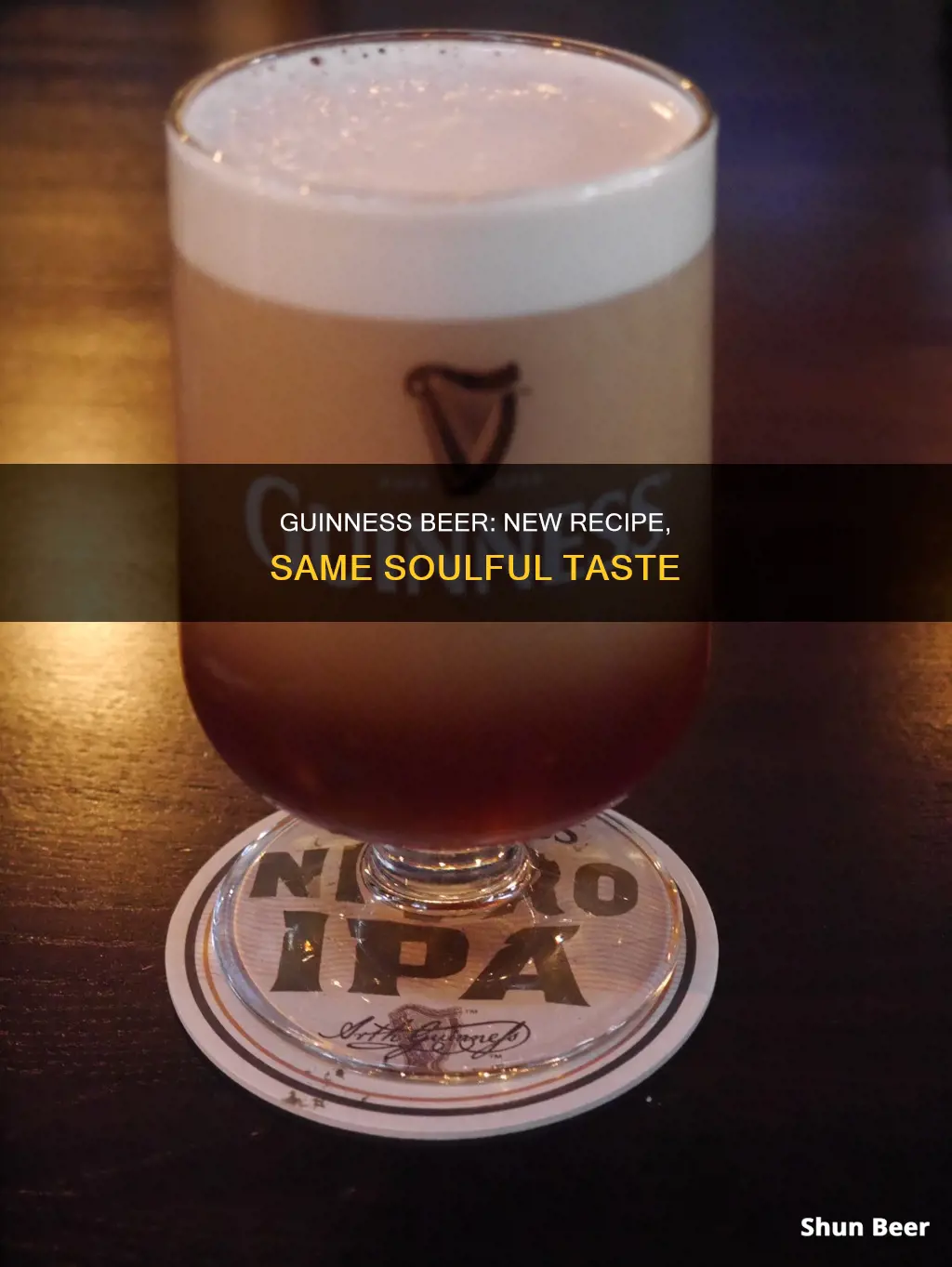
Guinness has expanded its product line in recent years, introducing new beers to the market. In 2022, the company launched a cold brew coffee beer in the UK, which combines the flavours of coffee, chocolate, and caramel. The product was already available in the US, where it had proven successful. In 2021, Guinness also celebrated the third anniversary of its Open Gate Brewery in Baltimore with the release of three new beers: Honey Amber Ale, Arm-in-Arm, and a Barrel-Aged Grand Cru. Additionally, Guinness opened a second American taproom in Chicago in 2023, showcasing small-batch beers. These innovations demonstrate Guinness' strategy to expand beyond its traditional pints and engage new consumers.
| Characteristics | Values |
|---|---|
| Type | Stout |
| Colour | Dark ruby red |
| Flavour | Roasted coffee and chocolate |
| Taste | Bitter, sweet, roasted |
| Alcohol by Volume (ABV) | 4.1% to 4.3% |
| Calories | 125 per pint |
| Country of Origin | Ireland |
| Year of Origin | 1759 |
| Founder | Arthur Guinness |
| Current Owner | Diageo |
| Number of Countries Sold | Over 100 |
| Number of Countries Brewed | Almost 50 |
What You'll Learn

History of Guinness
The history of Guinness begins with Arthur Guinness, who was born in 1725 in County Kildare, Ireland. In 1755, Guinness inherited £100 from his godfather Archbishop Price and used the money to lease a brewery in neighbouring Leixlip, County Kildare. He brewed only ale at the time and by 1759, he had made enough money to rent the larger but disused St. James’s Gate Brewery in Dublin, signing a 9,000-year lease at £45 per year.
When Guinness passed away in 1803 at the age of 78, the brewery was producing 20,000 barrels a year and had built up a successful export trade. Guinness's son, Arthur Guinness II, inherited the business and continued to expand the St. James’s Gate Brewery. By the 1830s, it was the largest brewery in Ireland.
In the 1850s, Arthur Guinness II's son, Benjamin Lee Guinness, took over the business. Under Benjamin, the business established the first trademark label for Guinness Stout in 1862. The trademark label included iconic features that are still in use today, like Arthur Guinness’ signature, the Harp device, and the name 'Guinness'. The business's success elevated the Guinness family’s status, and Benjamin became Lord Mayor of Dublin in 1851.
After Benjamin died in 1868, his son Edward Cecil Guinness took over the business. In 1886, Guinness was the world’s largest brewery and floated on the London Stock Exchange. It was the first major incorporated brewery, and in 1886, Edward became Chairman. A member of the Guinness family held this position until 1986. By the end of the 19th century, Guinness was producing 1.2 million barrels of porter every year, and the brewery had expanded to 60 acres with its own railway and fire brigade.
In 1951, Guinness established a new company, Guinness Exports Limited, to bottle and distribute Guinness internationally. By 1959, they launched Draught Guinness, dispensing Guinness using a gas dispensing system in bars for the first time. The dispensing system produced the famous creamy head that Guinness fans still love today.
In 1962, Rupert’s grandson Benjamin Guinness became Chairman. He was the last Guinness family member to hold this position and held it until 1986. In 1997, Guinness merged with another company, Grand Metropolitan, to form a company called Diageo PLC in a £24 billion merger. Diageo PLC retains the rights to all Guinness products and trademarks, so the beloved Guinness beer can remain the same.
The history of Guinness continues into the 21st century. In 2014, the incredible Brewhouse 4 brewery opened at St. James Gate in Dublin. It’s the largest stout brewery in the world and also one of the world’s most technologically advanced and sustainable breweries. Today, there are Guinness breweries in over 60 locations, and Guinness is sold in over 150 countries.
Guinness Beer: Hoppy or Not?
You may want to see also

Guinness recipes
Guinness is a dark, creamy stout beer with a distinctive ruby red colour. It pairs well with food and can be used in recipes to add a rich, deep flavour. Here are some recipe ideas using Guinness:
Irish Beef and Guinness Stew
This classic stew is a comforting dish, perfect for impressing guests or a cosy night in. The beef is cooked until it's fall-apart tender, and the gravy is a beautiful deep brown colour thanks to the Guinness. This recipe is best made with chunky pieces of beef and cooked low and slow to allow all the flavours to develop.
Malted Chocolate and Stout Layer Cake
This dessert is perfect for St. Patrick's Day or any special occasion. The chocolate cake is incredibly moist with a nice malt flavour, complemented by Irish cream frosting.
Guinness Float
Inspired by the creamy foam that gathers on top of a freshly poured Guinness, this quick and easy dessert combines vanilla ice cream with Guinness for a unique treat.
Guinness Corned Beef and Cabbage
A robust and traditional dish, this corned beef and cabbage recipe is slow-cooked to perfection, with the Irish stout adding richness to the dish.
Stout and Shiitake Pot Roast
This pot roast is full of flavour, with mushrooms, onions, and Guinness coming together to create a delicious meal. It's even better the next day!
Skillet Stout Brownies
These brownies are rich and fudgy, with a hint of stout flavour. They're perfect for a busy weeknight when you need a quick dessert fix.
Guinness adds a unique flavour to both sweet and savoury dishes, so get creative and experiment with this versatile ingredient!
The Evolution of the Guinness Beer Logo
You may want to see also

Guinness in other countries
Guinness is brewed in 49 countries and sold in over 150. The brand owns breweries in five countries: the original Dublin outpost, one in Malaysia and three in Africa, specifically Nigeria, Ghana, and Cameroon.
The United Kingdom is the biggest consumer of Guinness in the world, with one in every ten pints sold in London being a Guinness. Nigeria is the second-largest consumer of Guinness, followed by Ireland, the United States, and Cameroon.
Guinness has established a strong presence in Africa, dating back to the early 1800s when beer began being exported from Ireland to Trinidad, Barbados, and Sierra Leone as the British Empire expanded. Today, around 40% of the worldwide total Guinness volume is brewed and sold in Africa.
Football Stars in Guinness Beer Ads: Who's Featured?
You may want to see also

Guinness advertising
Guinness has a long and fascinating history of advertising, with some of the most recognisable and beloved campaigns in the world. For 170 years, the brand relied solely on word-of-mouth, with the belief that the beer itself was the best advertisement. However, in 1929, the first official Guinness advert appeared in the British national press with the now-iconic slogan, "Guinness is Good for You". This tagline was so memorable that people can still recite it 83 years later.
The early 20th century saw Guinness set the standard for beer advertising with witty and engaging ads, helping to create one of the best-known beers worldwide. The success of the brand's advertising is often attributed to the agency S.H. Benson, who was chosen to represent Guinness and created some of the most memorable poster and television advertisements. One of their most notable campaigns was "Guinness for Strength", featuring art by John Gilroy, an art director at the agency. Gilroy also created the famous Guinness toucan, which has become synonymous with the brand.
In recent years, Guinness has continued to produce award-winning and creative campaigns, such as the "Surfer" commercial, which received numerous accolades, including the Gold Lion at the Cannes International Advertising Festival in 1999. The brand has also explored little-known history with ads like "Tom Crean", which told the story of an Irish Antarctic explorer.
Guinness has a rich history and a unique approach to advertising, capturing the hearts and minds of generations with its clever, funny, and innovative campaigns.
Guinness Beer: Available in India?
You may want to see also

Guinness Storehouse
The Guinness Storehouse is a tourist attraction at St. James's Gate Brewery in Dublin, Ireland. It has been a working brewery for over 250 years and has received over twenty million visitors since opening to the public in 2000.
The Storehouse covers seven floors surrounding a glass atrium shaped like a giant pint of Guinness. The ground floor introduces visitors to the beer's four ingredients (water, barley, hops, and yeast) and the brewery's founder, Arthur Guinness. A copy of the 9,000-year lease signed by Arthur Guinness himself in 1759 lies at the base of the atrium.
Each of the seven floors offers a unique experience, from interactive exhibits on the brewing process and responsible drinking to the history of Guinness advertising. Visitors can even pour their own pint of Guinness and get a selfie printed on top of it! The Brewery Bar on the fifth floor offers Irish cuisine, with Guinness used in cooking and as an accompaniment.
The seventh floor houses the Gravity Bar, which offers unparalleled 360-degree views of Dublin. Visitors can enjoy a complimentary pint of Guinness with their admission while taking in the stunning views.
The Guinness Storehouse also contains the Guinness Archives, with records and artifacts dating back to 1759. It is a truly immersive experience, allowing visitors to delve into the unique history, heart, and soul of Ireland's most iconic beer.
Paleo Diet and Guinness Beer: A Healthy Match?
You may want to see also
Frequently asked questions
Guinness Blonde is an American amber lager and the newest Guinness beer. It was first brewed in Latrobe, Pennsylvania, and then moved to Guinness' Baltimore, Maryland brewery. It is designed for the U.S. market.
Guinness Blonde has an alcohol content of 5% ABV.
Guinness Blonde is an American-made lager, whereas the original Guinness is a traditional Irish stout.
The Mosaic and Citra hops used in Guinness Blonde lend the beer its citrus notes. It is a crisp, clean beer.
Guinness Blonde is best served cold in a pint glass. The ideal temperature is 42 degrees Fahrenheit, but no higher than 50 degrees.







